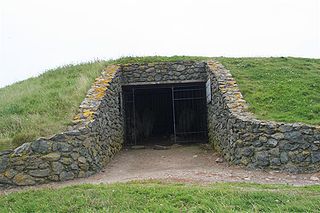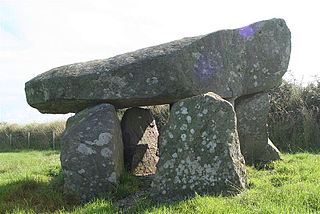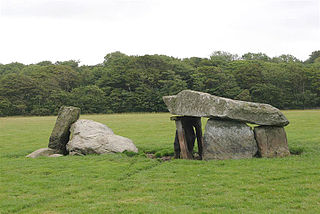
Din Dryfol is a Neolithic burial chamber on Anglesey, in Wales. It is a scheduled monument and is maintained by Cadw. [1] The monument is near Bethel. Three phases of use have been identified, all dating from the Neolithic period. [2]

Din Dryfol is a Neolithic burial chamber on Anglesey, in Wales. It is a scheduled monument and is maintained by Cadw. [1] The monument is near Bethel. Three phases of use have been identified, all dating from the Neolithic period. [2]
Din Dryfol is the remains of a burial chamber, part of a passage grave, a neolithic structure erected in several stages, and a type of burial structure more frequently found in Ireland than in Wales. The first part may have been constructed about 5,000 years ago. [1]
The dolmen is located on a level platform on the flank of a small hill and is oriented northeast to southwest. Excavations in the 1960s and 1970s have identified the different phases of the development. The first chamber was constructed with side slabs and a capstone, making a rectangular box some 3 by 1 m (10 by 3 ft) and about 2 m (7 ft) tall. This is the main structure that can be seen today, the capstone having slipped to one side to rest upon the ground. The second chamber was constructed to the northeast of this, and nothing remains of it now. However two post holes show where a wooden portal or some other structure stood. The third chamber was built to the northeast of the second one. It was about 5 m (16 ft) long and parts are still visible in the form of a small upright, a large portal stone standing 3 m (10 ft) high and some way away from the other stones, and a stone stump, perhaps the remains of another portal. The whole structure would have been covered with a mound of earth or rubble, probably small and circular over the original chamber, but much longer and rather wider when all three chambers had been constructed. Although this mound has disappeared, excavations suggest that it stretched for about 65 m (210 ft) and was about 15 m (50 ft) wide. [3] [4] Excavations have revealed pieces of pottery and cremation sites. [1]
The site showed evidence of disturbance during the Roman period, with Romano-British pottery unearthed during the 1970s excavations. It was also affected by road-building in the 18th and 19th century, when here was quarrying in the area. There is now no sign of a cairn or mound. [5] The monument was recorded in 1871 by H Pritchard, and excavated by F Lynch, firstly in 1969 to 1970 and again in 1980, which identified the phases of construction. [5] Wooden entrance posts to the second of three chambers, to the east of the earlier structure, were also identified. [2]

A megalith is a large stone that has been used to construct a prehistoric structure or monument, either alone or together with other stones. There are over 35,000 in Europe alone, located widely from Sweden to the Mediterranean sea.

Bryn Celli DduWelsh pronunciation: [brʌn keːɬi ðɨː] is a prehistoric site on the Welsh island of Anglesey located near Llanddaniel Fab. Its name means 'the mound in the dark grove'. It was archaeologically excavated between 1928 and 1929. Visitors can get inside the mound through a stone passage to the burial chamber, and it is the centrepiece of a major Neolithic Scheduled Monument in the care of Cadw. The presence of a mysterious pillar within the burial chamber, the reproduction of the 'Pattern Stone', carved with sinuous serpentine designs, and the fact that the site was once a henge with a stone circle, and may have been used to plot the date of the summer solstice have all attracted much interest.

Din Lligwy hut circle is an ancient village site near the east coast of Anglesey, close to the village of Moelfre, North Wales.

Barclodiad y Gawres is a Neolithic burial chamber between Rhosneigr and Aberffraw on the south-western coast of the island of Anglesey in North Wales. It is an example of a cruciform passage grave, a notable feature being its decorated stones. Similar graves and marks exist across the Irish Sea in the Boyne Valley.

Bodowyr Burial Chamber is a Neolithic burial chamber made of a few large stacked stones in a farmer's field on the north Wales island of Anglesey. It is located at Bodowyr Farm, 1.25 mi (2.0 km) east of Llangaffo, off the B4419 road.

Pentre Ifan is the name of an ancient manor in the community and parish of Nevern, Pembrokeshire, Wales. It is 11 miles (18 km) from Cardigan, Ceredigion, and 3 miles (4.8 km) east of Newport, Pembrokeshire. Pentre Ifan contains and gives its name to the largest and best preserved neolithic dolmen in Wales.

The dolmens of Jersey are neolithic sites, including dolmens, in Jersey. They range over a wide period, from around 4800 BC to 2250 BC, these dates covering the periods roughly designated as Neolithic, or “new stone age”, to Chalcolithic, or “copper age”.

The Tumulus of Bougon or Necropolis of Bougon is a group of five Neolithic barrows located in Bougon near La-Mothe-Saint-Héray, between Exoudon and Pamproux in Nouvelle-Aquitaine, France. Their discovery in 1840 raised great scientific interest. To protect the monuments, the site was acquired by the department of Deux-Sèvres in 1873. Excavations resumed in the late 1960s. The oldest structures of this prehistoric monument date to 4800 BC.

Tinkinswood or its full name Tinkinswood Burial Chamber, also known as Castell Carreg, Llech-y-Filiast and Maes-y-Filiast, is a megalithic burial chamber, built around 6,000 years ago, during the Neolithic period, in the Vale of Glamorgan, near Cardiff, Wales.

Lligwy Burial Chamber is a Neolithic burial chamber in Lligwy, near the east coast of Anglesey, Wales, United Kingdom. It consists of a circle of upright stones, made into a low chamber by a very large roof slab estimated at 25 tonnes. Excavation in 1909 found the remains of some 15 to 30 people, and pottery suggesting a late Neolithic date. Close to the village of Moelfre, the site is within a few metres of the road, where there is room to leave a single car for short periods.

The St Lythans burial chamber is a single stone megalithic dolmen, built around 4,000 BC as part of a chambered long barrow, during the mid Neolithic period, in what is now known as the Vale of Glamorgan, Wales.

Parc Cwm long cairn, also known as Parc le Breos burial chamber, is a partly restored Neolithic chambered tomb, identified in 1937 as a Severn-Cotswold type of chambered long barrow. The cromlech, a megalithic burial chamber, was built around 5850 years before present (BP), during the early Neolithic. It is about seven 1⁄2 miles (12 km) west south–west of Swansea, Wales, in what is now known as Coed y Parc Cwm at Parc le Breos, on the Gower Peninsula.

Innisidgen is the site of two Bronze Age entrance graves on the island of St Mary's in the Isles of Scilly. The two burial monuments, lie on a steep slope of Innisidgen Hill overlooking Crow Sound with a view towards the Eastern Isles.

The Grey Mare and her Colts is a megalithic chambered long barrow located near Abbotsbury in Dorset, England. It was built during the Early and Middle Neolithic periods. The tomb was partially excavated in the early nineteenth century, and was found to contain human bones and several pottery fragments.

Tŷ Newydd Burial Chamber is a Neolithic dolmen located northeast of the village of Llanfaelog on the Isle of Anglesey in Wales. It is located near Tŷ Newydd farm, and is in the care of Cadw.

Presaddfed Burial Chamber is a listed monument in Anglesey, north Wales, comprising two Neolithic chamber tombs. It is a scheduled ancient monument and is located a short distance northwest of Bodedern. It is maintained by Cadw.

Pawton Quoit is a prehistoric portal dolmen, which dates to the Early and Middle Neolithic period in England. The burial monument is located near Haycrock Farm, south of St Breock, in Cornwall, England.

Trefignath is a Neolithic burial chamber near Trearddur, south of Holyhead on Holy Island, off Anglesey in Wales. In its most complete form it included a large cairn covering three stone tombs, set on a small knoll. It was excavated between 1977 and 1979, revealing several phases of occupation with three separate burial chambers built in succession. It is a scheduled ancient monument, maintained by Cadw.

Pant-y-Saer is a Neolithic dolmen near the small town of Benllech in Anglesey, Wales. This burial chamber is partially collapsed with the massive capstone resting on the ground at one end. The remains of fifty-six people who were buried here have been found during excavations.

Killaclohane Portal Tomb is a megalithic tomb located in the townland of Killaclohane, about 2km east of Milltown, County Kerry. This Neolithic tomb dates to 3800 BC and is Kerry’s oldest man-made structure and earliest identified burial monument. In 2015, the portal tomb or dolmen was in imminent danger of collapse and was excavated and restored by a team led by Kerry County Archaeologist, Dr Michael Connolly. Prior to the excavation of Killaclohane Portal Tomb, very little was known about Neolithic settlement in Kerry and the beginning of agriculture.